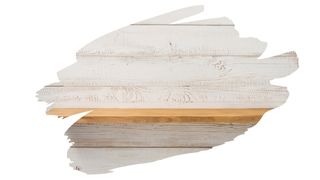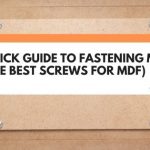A sturdy shelf needs to be made from sturdy stuff. Especially if it is going to be holding up hefty books or tool boxes.
Nevertheless, although putting up some shelves is an easy DIY job, things can sometimes go wrong. Or to put it more succinctly, even a well fastened shelf can begin to sag, if you made it from the wrong material.
So, in this post, you’ll find out what MDF’s compressional strength is…and why this matters for your DIY bookcase. You will also learn if MDF or Plywood is a better choice for interior shelving.
And keep reading to discover the top three reasons why you should NOT use MDF for shelving.

This post may contain affiliate links to products that we receive a commission for (at no additional cost to you). Learn more here.
Is MDF, Or Plywood, Better For My Interior Shelves?
Strength wise, Plywood is a far better choice.
Plywood is more rigid than MDF, which means it is less likely to sag in the middle. Also, it has more compressional strength too.
Compressional strength reflects how much compressional stress, (i.e. crushing force), a given material can take. The greater the compressional strength of a material, the better it will be as shelving.
And Plywood beats MDF in this regard.
Plywood can handle up to 5000 pounds of pressure per square inch (PSI).
Related Post: A Quick Guide To Choosing Between Plywood Or MDF For Shelves
While, MDF (aka Medium Density Fiberboard), can only hold up against 3500 PSI. This is still a decent amount of strength, but it doesn’t really compare to plywood.
How Thick Should MDF Be For Shelves? The ideal MDF thickness for shelves depends on the distance between the supports. If the supports for your shelf are spaced less than 700mm (27.5 inches) apart, then that MDF board should be at least 25mm thick.
Got It…So MDF Is No Plywood. Still, Is MDF OK For Bookshelves?
If you reinforce it with plenty of support, and only place lightweight items on it, then it can be. Nevertheless, this material isn’t a great choice for load-bearing in general.
You see, MDF is an engineered wood made up of compressed wood fibers and glue. And those wood fibers haven’t been compressed in a way that strengthens this material.
For example, Plywoods added strength comes from the fact that it has cross-layered ply veneers, making it more robust.
However, MDF doesn’t have the same engineered strength about it. Which is why placing heavy loads on an MDF shelves will only lead to sagging.
Plus, this doesn’t even take into account the fact that MDF is notorious for becoming easily water damaged.
If any moisture gets into MDF, this material will soak that moisture up. And once that happens, it will begin to rot, often becoming irrecoverably damaged.
What Are The Disadvantages Of Using MDF For A Bookcase?
The top three disadvantages to using this material are:
1). Fairly Weak Joints
MDF is a tricky material to fasten. It requires special screws, as other wood screws will loosen.
Plus, most types of water-based wood glues will fail to work properly with this water-wicking wood composite.
Related Post: A Quick Guide To Fastening MDF (+ The Best Screws For MDF)
2). Humidity Is Not MDF’s Friend
Any environment that has a lot of steam, humidity, moisture or splash-back should not have MDF in it.
Otherwise, MDF will absorb that moisture, and become water-damaged. Once that happens, it is very difficult to repair.
Related Post: Can You Really Use MDF Outside? (Best Practice Revealed!)
3). MDF Doesn’t Last That Long
Compared to natural solid wood, (and other manufactured woods such as OSB), MDF isn’t that durable.
Now, to be clear, MDF can last up to a decade if you keep it dry and inside. However, natural solid wood shelves can last twice as long (up to 20 years).
Related Post: Poplar Wood vs Pine (5 Things You Need To Consider)
So, if you want a long-lived shelf, MDF is not the right material choice for the job.
What About Particle Board? What Is Better For Shelves: MDF Or Particle Board?
Well, the name MDF is shorthand for the term Medium Density Fiberboard. However, Particle Board is sometimes referred to as Low Density Fiberboard.
And these two materials go through very similar manufacturing processes.
However, Particle Board (aka Chipboard) has less material packed into it. So, as a lower density board (compared to MDF) it is more likely to sag.
Related Post: Does Particle Board Furniture Need Special Screws (Vs Regular Wood Screws)?
Which is why, if you had to choose between the two, MDF is a better option for shelving.
Will An MDF Shelf Really Sag All That Much?
With enough support — and a dry environment — probably not.
However problems will arise, if you live in a humid climate. And the same goes if you plan on using MDF to add shelf space to a bathroom or kitchen.
Moisture, high humidity, and even changes in temperature, can cause MDF to swell and bow. And that can lead to sagging MDF shelves, (especially if they are loaded up with a fair few items).
Related Post: Why Is My MDF Board Warping? (+ How You Can Fix It)
To Wrap Up, Here Are The 3 Key Takeaways From This Post…
- 1). MDF is an engineered wood made up of compressed wood fibers and glue.
- 2). Plywood is a better choice for shelving, compared to MDF. This is because Plywood has more compressional strength than MDF, making Plywood shelves less likely to sag.
- 3). MDF shelves will need support if they are to be used as shelving material. Even so, MDF shelves are best suited for only holding up lightweight loads.
References:
Comparison of results obtained by static 3- and 4-point bending and flexural vibration tests on solid wood, MDF, and 5-plywood (degruyter.com)
Strength Properties of Wood for Practical Applications | Oklahoma State University (okstate.edu)



